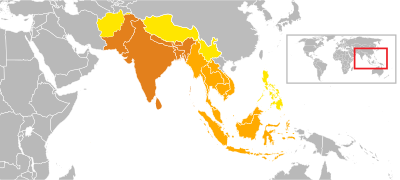ബൃഹദ് ഭാരതം
ബൃഹദ് ഭാരതം എന്നത് ഇന്ത്യൻ ഉപഭൂഖണ്ഡത്തിനുമപ്പുറം ചരിത്രപരമായി നിലനിൽക്കുന്ന ഇന്ത്യൻ സംസ്കാരമാണ്. പ്രത്യേകിച്ച്, ഇത് ഇന്ത്യയിൽനിന്നും ബുദ്ധമതവും ഹിന്ദു മതവും ആദ്യ നൂറ്റാണ്ടിൽ പട്ടുപാതവഴി തെക്കുകിഴക്കനേഷ്യയിലേയ്ക്കും മദ്ധ്യേഷ്യയിലേയ്ക്കും ചൈനയിലേയ്ക്കും പടർന്നതുമായി ബന്ധപ്പെട്ടും ഇന്ത്യയിലെ എഴുത്തുരീതിയായ തെക്കേ ഇന്ത്യയിലെ പല്ലവസാമ്മ്രാജ്യത്തിൽ നിന്നും പല്ലവലിപി തെക്കുകിഴക്കൻ ഏഷ്യയിലേയ്ക്കു വ്യാപിച്ചതും [1][2]ഗുപ്തസാമ്രാജ്യത്തിലെ സിദ്ധം ലിപി കിഴക്കൻ ഏഷ്യയിൽ എത്തിയതും 5 മുതൽ 15 വരെ നൂറ്റാണ്ടിലെ സഞ്ചാരികളും സമുദ്രവാണിക്കുകളും വഴിയാണ്. [3][4]തെക്കുകിഴക്കനേഷ്യയിൽ ഇന്ത്യാവത്കരിച്ച രാജസ്ഥാനങ്ങൾ ഇന്ത്യൻ ലിപികളും കെട്ടിടനിർമ്മാണരീതികളും ഭരണരീതികളും സ്വീകരിച്ചു.[5][6] പടിഞ്ഞാറാണെങ്കിൽ, ഹിന്ദുക്കുഷ് പാമീർ മലനിരകൾ എന്നിവിടങ്ങളിൽ ബൃഹദ് പേർഷ്യ ഭാരതസംസ്കാരത്തിനു അതിരിട്ടു.

മദ്ധ്യകാല യൂറോപ്പ്
തിരുത്തുകമദ്ധ്യകാല യൂറൊപ്പിൽ ആളുകൾക്കിടയിൽ മൂന്നുതരം ഇന്ത്യകളെപ്പറ്റിയുള്ള സങ്കൽപ്പം ഉണ്ടായിരുന്നു. ബൃഹദ്ഭാരതം എന്നാൽ തെക്കൻ ഏഷ്യയുടെ തെക്കേ അറ്റവും അപ്രധാന ഇന്ത്യയെന്നാൽ തെക്കനേഷ്യയുടെ ഉത്തരഭാഗവും മദ്ധ്യ ഇന്ത്യയെന്നാൽ മദ്ധ്യപൂർവ്വദേശത്തിനടുത്തുള്ള പ്രദേശങ്ങളും എന്നാണവർ സങ്കൽപ്പിച്ചത്. [7]ബൃഹദ്ഭാരതം(Greater India ) എന്ന പേർ പതിനഞ്ചാം നൂറ്റാണ്ടിന്റെ മദ്ധ്യകാലത്താണ് ഉപയോഗിക്കാൻ തുടങ്ങിയത്.[8][9][9] [10][11]) (പോർച്ചുഗീസ്: India Maior). പല മാനദണ്ഡങ്ങൾ ഉപയോഗിച്ചാണ് അന്ന് ഈ പേർ ഉപയോഗിച്ചത്. [12]ചിലസമയത്ത്, ഇന്ത്യൻ ഉപഭൂഖണ്ഡത്തെ മാത്രം കുറിക്കാനും ഈ പേർ ഉപയോഗിച്ചു. [13]
ഇന്ത്യാവത്കൃത രാജവംശങ്ങൾ
തിരുത്തുകതെക്കുകിഴക്കനേഷ്യയിൽ ഇന്ത്യയിൽനിന്നുള്ള ഹിന്ദു ബുദ്ധ സാംസ്കാര സാമ്പത്തിക സ്വാധീനം ആദ്യമായി വിവരിച്ചത് ജോർജ്ജ് കോഡിസ് ആയിരുന്നു.[14] ബുതുവാൻ, ചമ്പ, ദ്വാരാവതി, ഫുനാൻ, ഗങ്ഗ നെഗര, കദാരം, കലിൻഗ്ഗ, കൂടൈ, ലങ്കാസുക, പഗാൻ, പാൻ പാൻ, പോ-നി
തരുമനഗര, തൊന്ദൊ എന്നിവയാണ് തെക്കുകിഴക്കൻ ഏഷ്യയിൽ ആദ്യം സ്ഥാപിച്ച ഇന്ത്യൻ രാജ്യങ്ങൾ. ഒന്നു മുതൽ നാലു സി. ഇ (കോമൺ ഇറ) വരെയുള്ള കാലഘട്ടത്തിലാണ് സ്ഥാപിക്കപ്പെട്ടത്. ഇവ ഹിന്ദു സംസ്കാരവുമായി ബാന്ധവമുണ്ടായിരുന്നെങ്കിലും അവ സാംസാകാരികമായി അവ നിലനിന്ന പ്രദേശത്തെ സംസ്കാരവുമായാണ് കൂടുതൽ അടുത്തുനിന്നത്. ശ്രീവിജയസാമ്രാജ്യവും മജാപാഹിത്, ഖ്മർ സാമ്രാജ്യവും ഹിന്ദു സംസ്കാരം പിന്തുടർന്നെങ്കിലും അവ തങ്ങളുടെ അതിരും വാണിജ്യപ്രവർത്തനങ്ങളും കൊണ്ട് ഇന്ത്യയ്ക്കു വെല്ലുവിളി ഉയർത്തിയിരുന്നു. ഇതുവരെ നിർമ്മിച്ചതിൽ ഏറ്റവും വലിയ ബുദ്ധമത സ്മാരകമായിരുന്നു ഇന്തോനേഷ്യയിൽ ഇന്നും തലയുയർത്തിനിൽക്കുന്ന ബൊറൊബുദുർ ക്ഷേത്രം. [15]
അവലംബം
തിരുത്തുക- ↑ Languages and Cultures: Studies in Honor of Edgar C. Polomé by Mohammad Ali Jazayery,Edgar C. Polomé,Werner Winter p.742
- ↑ The World's Writing Systems by Peter T. Daniels p.446
- ↑ Rajan, Vinodh; Sharma, Shriramana (28 ജൂൺ 2012). "L2/12-221: Comments on naming the "Siddham" encoding" (PDF). Retrieved 19 ഓഗസ്റ്റ് 2014.
- ↑ Monier-Williams Sanskrit-English Dictionary, page 1215, col. 1 http://www.sanskrit-lexicon.uni-koeln.de/monier/
- ↑ Southeast Asia: A Historical Encyclopedia, from Angkor Wat to East Timor, by Keat Gin Ooi p.642
- ↑ Hindu-Buddhist Architecture in Southeast Asia by Daigorō Chihara p.226
- ↑ By J. R. S. Phillips, The Medieval Expansion of Europe, page 192, Oxford University Press, 1998, ISBN 9780520207424
- ↑ [1]
- ↑ 9.0 9.1 ഉദ്ധരിച്ചതിൽ പിഴവ്: അസാധുവായ
<ref>ടാഗ്;azuraraഎന്ന പേരിലെ അവലംബങ്ങൾക്ക് എഴുത്തൊന്നും നൽകിയിട്ടില്ല. - ↑ Martin W. Lewis and Kären Wigen, The Myth of Continents: A Critique of Metageography, page 269, University of California Press, 1997, ISBN 9780520207424
- ↑ Terras de Além: no Relato da Viagem de Vasco da Gama
- ↑ (Beazley 1910, p. 708) Quote: "Azurara's hyperbole, indeed, which celebrates the Navigator Prince as joining Orient and Occident by continual voyaging, as transporting to the extremities of the East the creations of Western industry, does not scruple to picture the people of the Greater and the Lesser India welcoming his ships (which never passed beyond Sierra Leone), praising his generosity, and even experiencing his hospitality."
- ↑ (Beazley 1910, p. 708) Quote: "Among all the confusion of the various Indies in Mediaeval nomenclature, "Greater India" can usually be recognized as restricted to the "India proper" of the modern world."
- ↑ National Library of Australia. Asia's French Connection : George Coedes and the Coedes Collection Archived 2011-10-21 at the Wayback Machine.
- ↑ Theories of Indianisation Exemplified by Selected Case Studies from Indonesia (Insular Southeast Asia), by Dr. Helmut Lukas
കൂടുതൽ വായനയ്ക്ക്
തിരുത്തുക- Language variation: Papers on variation and change in the Sinosphere and in the Indosphere in honour of James A. Matisoff, David Bradley, Randy J. LaPolla and Boyd Michailovsky eds., pp. 113–144. Canberra: Pacific Linguistics.
- Ankerl, Guy (2000). Global communication without universal civilisation. INU societal research. Vol. Vol.1: Coexisting contemporary civilisations : Arabo-Muslim, Bharati, Chinese, and Western. Geneva: INU Press. ISBN 2-88155-004-5.
{{cite book}}:|volume=has extra text (help)